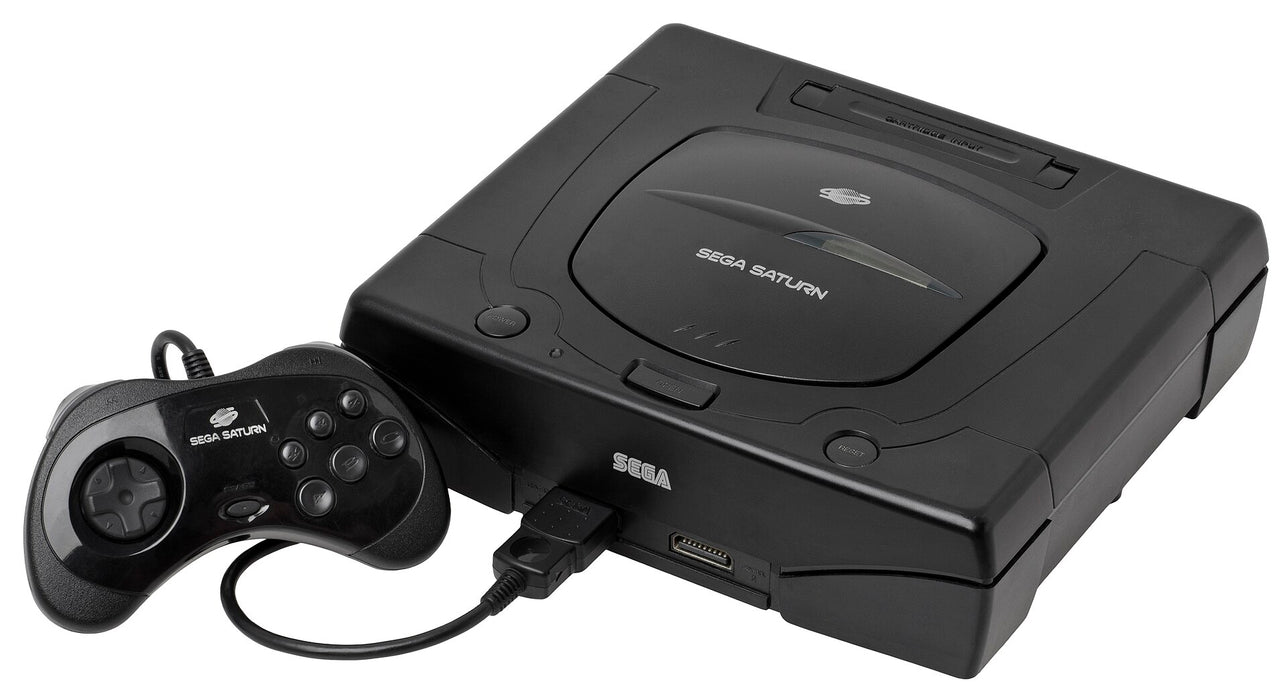
Sega Saturn (USED) - console (RESTART)
Sega Saturn (used guaranteed)
The Sega Saturn (セガサターン, Sega Satān ) it's a console Of fifth generation produced by SAW from 22nd October 1994 to August 10th 1998.
Presented in Japan October 22nd 1994, it was marketed in the Asian country starting from November 22 of that same year, and in the West in 1995, before being replaced by the Sega Dreamcast.
The Saturn compared to the PlayStation can boast a greater number of polygons simple to generate and is able to offer a slightly higher graphic resolution, even if the PlayStation, having a hybrid GPU dedicated to the management of 3D effects (texture mapping, flat gouraud shading, alpha blending), is superior in the final rendering of three-dimensional environments/structures.
However, the platform's hardware was difficult to program. and this meant that for almost all games the modest superiority in terms of polygons and resolution compared to the PlayStation was imperceptible or non-existent, with the exception of proprietary games which, especially with the improvement of the new operating system, managed to make the most of every aspect of the console.
Saturn programmers had to manage two CPUs and a third coprocessor, the graphics part is divided into two units (VDP1 and VDP2), one dedicated to the management of three-dimensional graphics and another dedicated to the improvement of 2D graphics. Another of the features that distinguished the Saturn from other consoles was that it had an adapter for the modem called Sega NetLink to connect the machine to the server SegaNet, but the hardware it had to be purchased separately.
Controller
The controller that came with the console is a gamepad to D-pad, with six front buttons and two rear buttons.
In 1996, the Saturn 3D Pad was released, a larger, almost circular controller that also featured a thumbstick. analog placed on the front above the D-pad and analog triggers instead of shoulder buttons. It was designed to optimize some of the most successful games; among the titles that benefited most from 3D Pad support are Daytona USA: Championship Circuit Edition , Sega Touring Car Championship , Sonic 3D: Flickies' Island , Quake And Doom . Although it was quite innovative, the success of the 3D Pad did not reach expectations, probably due to the high launch cost and excessive bulk. A similar concept was however taken up again with greater success with the controller of the Dreamcast.
Since 1994 the joystick Virtua Stick, with knob style lever arcade video game and 8 face buttons, also released in 1996 in a version even more similar to the classic arcade controls. In 1995 the joystick with analog stick was released Mission , larger and also equipped with integrated buttons, can be moved to the left or right side of the base with respect to the keypad. Other variations of the joystick include the dual arcade control Virtua Stick Pro (1996), which resembles the control panel of a two-player arcade cabinet, and the Twin Stick double lever (1996).
Other peripherals include the Arcade Racer steering wheel (1995) and the optical gun Virtua Gun (1995). The multi-tap allows you to connect up to six controllers to each port.
Technical specifications
- Central Processing Unit:
- 2 x Hitachi SuperH 2-32 bit @28.63MHz
- 8 KB cache first level
- Overall performance in MIPS: 25 MIPS (single CPU)
- Motorola 68EC000 @11.3MHz (control sub-processor of the Programmable Sound Generator )
- Overall performance in MIPS: 1.5 MIPS
- 2 x Hitachi SuperH 2-32 bit @28.63MHz
- Graphics Processing Unit:
- VDP 1-32 bit @28.63MHz (this processor is responsible for processing sprite And polygons)
- VDP 2-32 bit @28.63MHz (this processor is responsible for processing wallpapers)
- Peak graphics rendering of 500,000 monochrome polygons per second (200,000 with textures and shadows)
- 16.7 million colors
- Memory:
- 5 Mbyte RAM of non-unified type
- 1 Mbyte SDRAM
- 1 Mbyte DRAM
- 1.5 Mbyte VRAM dedicated to the video processor
- 512 Kbyte RAM dedicated to the audio processor
- 512 Kbyte CD-ROM cache
- 512 Kbyte BIOS ROM
- Resolutions:
Progressive mode: from 320×224 at 704×224 at 29.97fps NTSC or 320×256 at 704×256 at 25.0fps PAL. Interlaced mode: 320×448 at 480i60 (704×480) NTSC or 320×512 to 704×512 (512i50) PAL
It must be said that there were no predefined resolutions, but it is possible to have one of the following horizontal resolutions, 320, 352, 640 and 704, while among the vertical resolutions you have as progressive, 224, 240 and 256, while as interlaced 448, 480 and 512
The standard aspect ratio for video output is 4:3 (although many games apply black bars at the top and bottom to make the image 14:9), but some games allowed an output through the settings anamorphic video and then render the image at 16:9, while maintaining the same output resolution
- 5 Mbyte RAM of non-unified type
- Sound:
- Yamaha FH1 22 channel stereo
- Storage Media:
- Electronic cartridges
- CD-ROM
- Communication ports:
- 2 PAD ports on the front
- Communication Connector port used for the SEGA Netlink Modem
- Top expansion port, used to increase the hardware resources of the machine, additional resources required by some games and some require specific cuts of additional memory, while others, even if they don't need it to function, can use it to improve the effects
- Rear expansion port (hidden by a removable cover, which also gives access to the backup battery) for the "Video CD Card" or "Movie Card" to allow the use of Video CDs
- Power port for C7 cable
- DIN 10 type video output port




